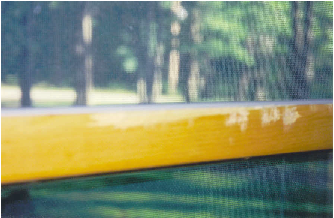Bite Marks... and "Train Tracks"
Biting is something I had not recently paid particular attention to since Zachary had not really done it in a while. But, recently, as I played with him one day, I noticed something rather interesting happened when I took away the toy he had been spinning. I had been wearing shorts that day... something I rarely do. When Zachary could no longer spin, he proceeded to make a bite mark on my arm. I would have paid no attention to this in the past, except that lately, I've trained myself to observe his every move, the motion of his eyes to see the object of his fascination, to observe his every utterance, etc.
Well, since this had been the first bite mark in a long time, something really jumped out at me this time. I noticed that after Zachary made the bite mark, he looked at it for a few seconds, fascinated by it. When I asked him what "that was" on mommy's arm, he responded: "train tracks". How interesting! Could this too be explained by my theory on partiality? A circular bite pattern on the skin, after all, forms a "whole" and his referring to it as a train track really made me wonder. Later, Zachary would call bite marks "teeth tracks".
Why exactly do children bite? Normal children bite... and when they do so, it is usually because they are upset with someone or frustrated. The same is, in my opinion, completely true for the autistic child. The life of the autistic child is defined by frustration and thus it makes perfect sense that biting is so prevalent in these children. I now believe that biting, in the autistic child, is but another coping mechanism, one used especially in dealing with frustrations that cannot be eliminated via spinning or other "coping strategies". This coping mechanism of biting I clearly saw in Zachary. When frustrated by my partially open living room or bedroom windows - things he could not "spin" - he simply resorted to biting to deal with the frustration of the situation. This was also evident from the biting around the windows in Zachary's Room Of Colors
The picture below, although taken recently, shows Zachary's bite marks from approximately a year ago. I now see that Zachary had bitten the wooden window frame in an attempt to cope with the fact that the window was half open and "half" represented a "partiality", an "in between", a "part to the whole" he simply did not understand and simply could not cope with. I'm happy to say that having worked with fractions in helping Zachary has greatly helped him cope with these issues of "parts to the whole"... because now, I can label the window as "half open" and that "half open" becomes an entity in and of itself and is no longer viewed as a "part" by Zachary. Biting open window frames is thus no longer an issue.

I do think that biting also has some actual physical implications in addition to it being a coping mechanism. In the past, I had always found that foods high in phenols seemed to increase overall biting. I don't know if that had simply been a coincidence... that I had noticed the biting on days he took phenolic foods... Since Zachary has been on enzymes, however, biting has all but disappeared. It comes back once in a while, but infrequently and less intensely. Obviously, I can't say for sure whether the overall disappearance of biting is due to the fact that digestive enzymes somehow help by better breaking down the phenolic foods, or whether this disappearance is due to the fact that Zachary can now cope much better with his world given that I now understand him so well and can much more easily help him deal with his frustrations via the use of labels and explanations as to how things fit together. Zachary now understands it is not acceptable to bite.
This is one behavior I try to extinguish quickly when it does surfaces. I understand biting provides a coping mechanism for Zachary and hence, the trick in extinguishing biting as a coping mechanism, in my opinion, lies in helping the autistic child deal with frustration in another way. As such, when biting occurs, I encourage parents not to punish their autistic child but rather to look for the source of frustration and to provide for the child an understanding of how the source of the child's frustration "works"... to provide an understanding of the parts to the whole to better help the child cope with issues of partiality... and again, this may be as simple as "labeling" a window as "half open". :o)